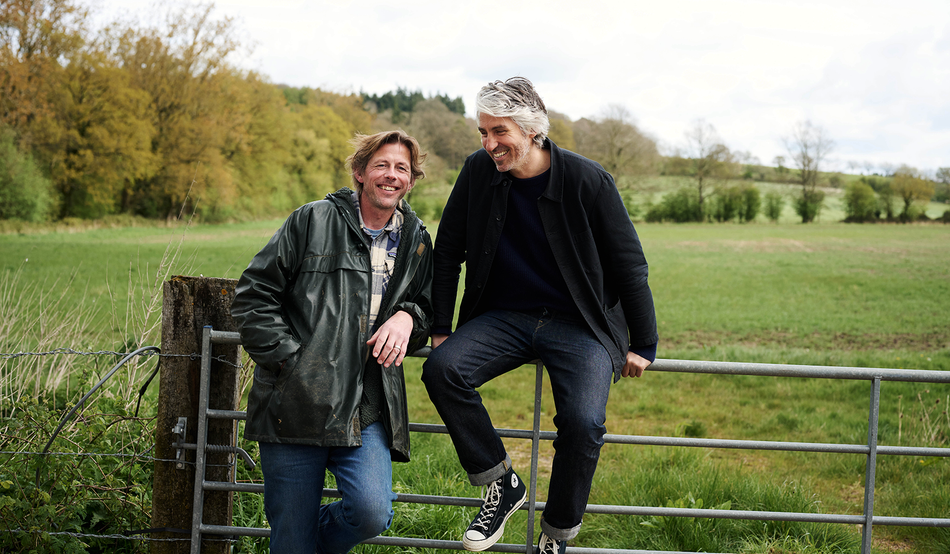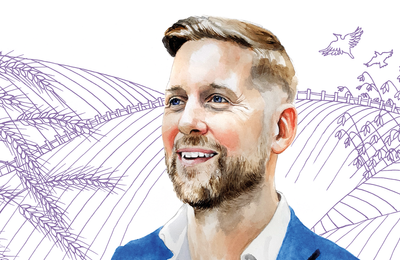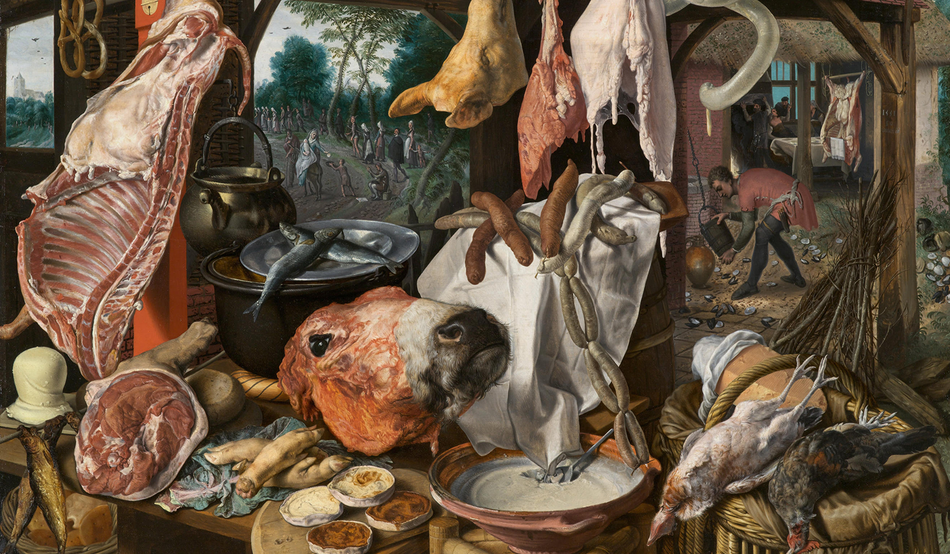When Andy Cato first got the call from Jeremy Clarkson, he thought he was just going to Diddly Squat for a cup of tea. As he arrived, the cameras for Clarkson’s Farm series 3 were rolling. His wish to bring regenerative farming to the mainstream, the fulfilment of a 20-year journey, had been granted. But the stakes were high. In that moment, he asked himself “how do you define ‘regenerative farming’ in 10 seconds to 50 million people? Don’t get this wrong.”
“Our current farming system declares war on natural systems,” he began. “Our soils have been pounded and poisoned to a point where they’re within a few decades of giving up. We’ve lost 80 per cent of our insects. So, we can’t keep doing that. And regenerative farming is a way of farming which tries to copy natural systems.”
To demonstrate this, he dug out a spade of soil from Clarkson’s tired, ploughed-and-fertilised field. And he dug a spade from the hedgerow next to it. The former was dry and lifeless, the latter was full of worms, creepy crawlies and micro-fungi. Regenerative farming, in essence, is about turning crop fields into the latter—using nature, wildflowers, roots and worms to rejuvenate soil health, and in so doing improve crop nutrition and reverse the collapse in pollinators and wildlife.
To the surprise of many in the environmental community, me included, Clarkson didn’t mock 6ft8 Cato as a lanky tree-hugger before revving off in his Lamborghini tractor. Instead, he became an advocate, saying, in a trademark piece to camera: “without insects, all life on Earth ends. Everything. And that’s me talking.” Later, he promised “to put Mother Nature in the driving seat.” And “Ultimately, it’s all about the soil. So you go back to sort of old-fashioned farming.” Clarkson got it.
It helped that this wasn’t Cato’s first time in front of the camera. He is one half of 1990s dance duo Groove Armada, with whom he spent 15 years touring the world. But in the late noughties, feeling burnt out and with a young family, he bought a farm in Gascony, France, to recuperate.
He soon started growing a vegetable patch and reading books about permaculture and companion cropping (growing complimentary plants next to each other, removing the need for artificial fertiliser or pesticide). As the hobby grew, he began selling produce at the local market. And then in 2011 he made what he calls the “absolutely mad decision” to sell the publishing rights to his songs, “effectively your pension as a musician”, to fund the purchase of 110 hectares of land around his farm. He became a full-time, regenerative farmer.
The short story is that Cato became a master farmer, growing heritage wheat that made the most popular bread in the region—including a loaf for the president of France. The long story included “some really, really dark days” and hard lessons through trial and error. But having conquered one country (he was awarded the Lauréat National de L’Agro-Écologie in 2020 for “the most innovative farm in France”) he returned to England in 2021 to take on the 20-year tenancy of a National Trust farm estate in West Oxfordshire—the Trust commending his “regenerative way with soil health, nature and carbon” in his successful bid. But this time his plan wasn’t just to change one farm. It was to change farming.
Along with business partner George Lamb, he set up the company Wildfarmed to give other farmers the opportunity to work in the same way. They could sign up to a short list of requirements (even just for a single trial field, as Clarkson did) which include: keeping soil covered at all times with species-rich cover crops, growing cereals alongside companion crops, integrating animals wherever possible (their manure is a natural fertiliser), having no pesticides, or -cides of any kind on growing crops, and crops never being more than 80 metres away from wildflower strips. Unlike organic certification, which typically requires a two-year transition period, farmers could become Wildfarmed-certified straight away.
Cato’s venture also guaranteed a fixed price for wheat and oat, two cereal crops with wildly fluctuating market rates—a major draw. And due to their lack of fertiliser and pesticides seeping into waterways, four major water companies in the UK, including Southern Water and Wessex Water, even pay Wildfarmed growers between £70 to £200 per hectare just to keep doing what they do.
Wildfarmed now has a network of 150 farms across the UK and France, supplying flour and oats to the likes of Nandos and Ask Italian. You can buy loaves of Wildfarmed bread from Waitrose, Ocado and, as of June 2025, Tesco. Giles Coren even complained in a Times restaurant review, in the ultimate back-handed compliment, of Wildfarmed flatbreads becoming “ubiquitous”. Ubiquitous is the goal. Wildfarmed has long-established relationships with artisan bakeries, but the aim was always to break the mainstream. “The Road To Greggs” was a goal pinned to the team noticeboard for years; they achieved it in April 2024.
I visit Cato’s Oxfordshire farm during a supplier field day in July, the only journalist allowed to slip through the net. The first thing that strikes me, as I accept a pain-au-raisin made from Wildfarmed flour, is the number of wasps buzzing around—I haven’t seen so many since my childhood. The caterers keep the pastries firmly under hessian, daring to lift it for a millisecond to whip out a sticky bun, only for the eager recipient to run around the courtyard attempting to escape the marauding insects. One bug lands in my tea.
I remember childhood picnics like this—the farce of flapping hands and flying jam sandwiches—but it is an old memory. Once out touring the fields with farm manager Ed Brown, however, I begin to see why this feels like time travel. He stops by a wheat field, ringed by wildflower strips, including phacelia and a scattering of sunflowers being mobbed by bees, hoverflies—and wasps.
“We’re actively trying to reduce the nature loss in this country”, says Brown. As well as pollinators, there has been a 54 per cent decrease in the distribution of flowering plants since 1970 and a 58 per cent decline in farmland birds. “We can have farming practices that are inherently good for nature,” though, says Brown. But in Wildfarmed fields, research shows an 80 per cent increase in insect biomass in Wildfarmed fields, including 3.7 times more bees.
Cato describes soil as “the microbiome of the plant”, as critical to crop health as our gut is to our body. “The soil microbiome will determine the type of plant that grows out of it in the same way that the gut microbiome will determine the kind of human that's supported by it”, he tells me. “We’re only just beginning to scrape the surface of understanding this extraordinary exchange… But what we do know are the conditions in which that exchange thrives, which is keeping soil covered with a diversity of plants for as much time as you can.”
The modern process of “conventional” farming is, in historical terms, totally unconventional. Farmers have been spraying huge volumes of chemicals out of heavy industrial machinery for barely a hundred years—and already, we are learning the consequences, with dead soils, crashes in the nutrition value of plants, and collapsing wildlife populations. The Green Revolution crop boom of the 1960s, enabled by artificial fertiliser, was extraordinarily successful but could only ever produce a short-term boost. By contrast, says Cato, hand-cultivated East-Asian terraces, “remained fertile for 40 centuries because of a combination of minimised tillage, plant diversity, soil cover, multi-cropping, poly-cropping.” But mechanised agriculture, based around the plough, means “our soils have been going backwards.” After thousands of years, the soil fertility of the American prairies was destroyed in just one generation of ploughing, leading to the Dustbowl of the 1930s.
Critics of regenerative farming point out that the crop yields are lower on regenerative fields than conventional ones, arguing that it wouldn’t be able to feed the world. But this rather misses the point. Not only does conventional agriculture achieve its high yields through chemicals that slowly kill the soil, it is wasteful: the world uses twice as much nitrogen fertiliser as it needs, and up to just 35 per cent of nitrogen-based fertiliser is taken up by crops.
Crucially, artificial yields currently produce enough food globally to feed ten billion people—far more than needed. The issue isn’t food production, it’s distribution. This overproduction comes at a catastrophic cost to local wildlife, biodiversity and nutrition, which ultimately harms human populations too. Producing slightly less, then, would be far from a valid flaw of regenerative farming—it should be the aim.
A stronger argument is that, unlike organic, “regenerative” is an uncertified term and can be hijacked by large agri-businesses. The so-called “Agribusiness Task Force” plan in 2022 to “scale regenerative farming”, for example, was backed by Mars, McCain Foods, McDonald’s, Mondelez, and PepsiCo, among others. It has since been merged with initiatives including King Charles’ Terra Carta and “Routes to Regen”, and has an even broader coalition of partners, including Wildfarmed.
Yet the lack of definition or recognition of the term “regenerative” is arguably circumvented by Wildfarmed. Cato dislikes the word “certification”, yet all Wildfarmed farms have signed up to a clear code of practice and list of requirements—certification in everything but name. Wildfarmed also works closely with Regenified, an American company that has published a list of requirements needed to earn the label of “regenerative”. (Regenified also has a retort to the yield dilemma, finding that in times of drought and flood, which are increasing due to climate change, regenerative farming produces a 30 per cent increase in yield.).
Regenerative farming needn’t be a rival to organic farming, either. Helen Browning, chief executive of the Soil Association—the UK’s organic certification body—is a wheat supplier to Wildfarmed. “We do need to change the world at pace,” she said in June 2022, “If we sort out our arable ground in the next five years through [the Wildfarmed] approach it would be revolutionary—it would shift the whole mainstream of farming in the right direction.”
When Cato was working his fields in France, the idea that food from his fields would be in Greggs and Tesco seemed unachievable. And “if you look at the amount of flour going through UK mills every day, we’re just decimal points”, he says. He estimates that well over 90 per cent of farming is still conventional, not regenerative. But he is proud of “changing the conversation across the whole of the supply chain.”
Next in Cato’s crosshairs is Defra policy. He tells me he’s been working with Minette Batters, the former president of the National Farmers’ Union, who has recently been appointed to lead a review of farm profitability. He’s trying to persuade her that the government should measure net gains in biodiversity (BNG) on land that produces food, as well as on “non-productive” land. Currently, BNG is a metric largely for housing developers, who are required to “deliver at least 10 per cent BNG”—some trees and hedges alongside bricks and tarmac. There isn’t however, a BNG measure or reward for making farmed land more biodiverse through regenerative practices. Cato thinks there should be, and hopes to see it in Batters’ forthcoming review.
Similarly, billions are spent on flood defences, he notes, “when the only real way to have flood resilience is to improve the quality of our soils, which is so much more affordable.” Just a couple of weeks after we speak, Defra Secretary Steve Reed announced that the sustainable farming incentive (SFI) would be relaunched, including payments for reduced water pollution on farmland. Policy, it seems, is playing catch-up with Wildfarmed.
Politicians are perhaps more willing to listen now that Wildfarmed has reached a wider audience. Cato’s opportunity to “define regenerative farming in 10 seconds to 50 million people” on Clarkson’s Farm certainly landed. On a recent trip to Cornwall, he tells me, “we stopped at a service station, and there was a group of young builders going off for a weekend raving. One of them said, ‘aren’t you the biodiversity bloke from Clarksons?’ And then on arrival in Cornwall, we went to the most remote pub in the most remote place, sat in this beer garden under the drizzle, and a guy said, ‘Do you mind if I get a photo with you? You’re the nature bloke from Clarksons, aren’t you?’”
He laughs. “I’ve spent 25 years in music, at a moderately well-known level. But I’d never been stopped for selfies until I did Clarkson’s Farm!” Even more so than “I love your songs”, then, it's “I love your soil” that drives Cato now. And it may yet drive a farming revolution.















